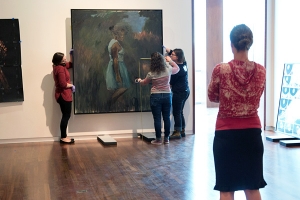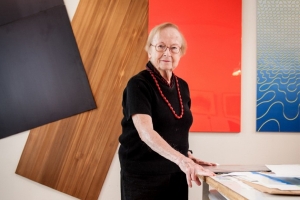Displaying items by tag: Woman artist
Women in Art: Whitney Tassie
Written by Allison Pinegar.
Whitney Tassie is the curator of modern and contemporary art at the UMFA and the woman behind the upcoming exhibition A Fuller Picture: Selections from the Modern and Contemporary Collection for the UMFA’s reopening on August 26, 2017. In preparation for the all-women show, The Finer Points will be highlighting female artists from the UMFA’s collection, the state of Utah, and the University of Utah.
In 2015 Art News reported the statistics of female representation in the art world. The statistics are staggering, revealing that despite recent efforts of art institutions, there is still significant bias. Maura Reilly’s article is partly what inspired Whitney Tassie, the UMFA’s curator of modern and contemporary art, to curate an all-women show for the museum’s reopening in August. “When you see the numbers it’s shocking. The arts are not a particularly stat-heavy industry, it’s fairly unregulated. But when someone takes the time to do that it’s very telling,” Tassie explains. And she’s not wrong – in April 2015 only 7% of the works on display from their permanent collection at the Museum of Modern Art were by women. Reilly’s call to “right the balance” is not off base nor petty.
Tassie’s exhibition, A Fuller Picture: Selections from the Modern and Contemporary Collection will showcase works by female artists from the UMFA’s permanent collection, including both local, national and international artists. Works by names like Yayoi Kusama, Anna Campbell Bliss, Helen Frankenthaler, Jann Haworth, and a new Faith Ringgold acquisition will be on display for two years. The Kusama and Frankenthaler pieces were the first two works Tassie knew needed to be displayed in the new gallery space. From there, she began to consider how these various artists expand the definitions of movements like abstract expressionism, minimalism, and pop art, but also how some of these women defy those categories, complicating the traditional art historical narrative.
While shows featuring only women are gaining popularity, they are still problematic in some sense. “It is a problem that we’ve only seen these women in all-women group shows. Let’s talk about that,” Tassie presses. “It opens myself and the museum up for criticism, but in doing that we start a dialogue and we can talk about the history of exhibitions and of representation of women artists in museum collections.” Acknowledging the “baggage” that comes with doing a show like this offers opportunities for visitors to really consider the role of the museum. To further emphasize these issues, the exhibition will include a reading nook where visitors can learn more about the history of women in the art world and the statistics that prompted Tassie to curate A Fuller Picture.
The UMFA seeks to be a place of inclusion and scholarship, as well as to provide compelling, relevant, and insightful exhibitions for the University and local community. These goals were upheld in the remodel. “The changes we’re making in how visitors engage with the art and the Museum’s unique spaces will make the UMFA more relevant than ever in the lives of our audiences,” UMFA executive director, Gretchen Dietrich said in an April press release. A Fuller Picture encompasses these goals, offering space for patrons to consider why art museums own more art made by men than women, and what it means to be a woman. Tassie states, “I am grateful that the museum can be a platform for these conversations that are feeling ever-more urgent today – a renewed urgency, anyway – to talk about feminism and to try to dispel some of the myths or paint a more inclusive picture of feminism or art history.”
Be sure to catch A Fuller Picture: Selections from the Modern and Contemporary Collection when the UMFA reopens to the public on August 26, 2017. The reopening will include a two-day celebration featuring talks, tours, films, a dance part and more! For additional information about the UMFA, visit UMFA.
Artist Highlight: Anna Campbell Bliss
By Guest Writer and MFA Student, Allison Pinegar
Anna Campbell Bliss is just one of the artists who will be featured in the all-female exhibition in the UMFA’s Contemporary and Modern gallery when it reopens on August 26, 2017. In preparation for the all-female show, The Finer Points will be highlighting female artists from the UMFA’s collection, the state of Utah, and the University of Utah.
The work of Anna Campbell Bliss is organized and structural, yet organic and experimental. The first thing that typically hits the viewer when confronted with Bliss’ work is the extraordinary use of color. A student of the Bauhaus greats like Walter Gropius of Harvard and Josef Albers of Black Mountain College, Bliss developed a unique way of integrating color theory with architecture and technology. While her style is difficult to define, one common theme throughout her career is intersectionality. Bliss’ works combine form, pattern, structure, color, texture, science, mathematics, nature, dance, and poetry.
Bliss moved to Salt Lake City with her husband Robert when he accepted a teaching position in the School of Architecture at the University of Utah. Moving from Minneapolis, the Blisses left behind their active architecture firm, Bliss & Campbell Architects, and a vibrant arts community where they were highly involved with the Walker Art Center. When Bliss arrived in Utah in 1963, she felt as though she had been exiled to a “cultural desert.” The lack of art funding and activity in Salt Lake pushed Bliss to establish the Contemporary Arts Group, a group of artists, engineers, dancers, poets, and architects working together to build up support for the arts in Utah.
A true descendent of the Bauhaus, Bliss looked to Utah’s burgeoning technology industry for additional creative inspiration. Much of Bliss’ later work uses computer algorithms and draws from scientific experimentation. Bliss’ was never fully dependent on computers or technology in her process – she firmly believed in the significance of the artist’s hand. That unique touch is what allows these various disciplines to work together cohesively.
Bliss’ ties to the University of Utah through her husband allowed the UMFA and the University to collect a considerable amount of Bliss’ work. Extended Vision, a large mural commissioned for the Cowles Mathematics Building in 2001 is a significant addition to the sixteen pieces in the UMFA’s permanent collection. Bliss worked well through retirement age before her career garnered serious attention and was still actively working when she passed away in 2015 at the age of 90. Some of her works have been collected by large institutions, but she did not receive her first commission until 1989 at the age of 64 when she installed Windows at the Salt Lake Airport.
Anna Campbell Bliss ushered modernism into Utah’s art world and stimulated the Salt Lake art community into much of what it is today. Be sure to look for Bliss’ Celebration in the UMFA’s contemporary gallery when it re-opens in August 2017.



